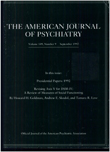Axis II comorbidity in substance abusers
Abstract
OBJECTIVE: To assess the complex relationship between substance abuse and personality disorders, the authors determined the prevalence of personality disorders in a group of middle-class substance abusers and compared the subjects who had personality disorders with those who did not. METHOD: The subjects were drawn from patients consecutively admitted to an inpatient substance abuse program in a private psychiatric hospital; they were the first 100 who agreed to participate. Substance dependence was diagnosed according to DSM-III-R, and the patients were assessed with the Structured Clinical Interview for DSM-III-R Personality Disorders, Alcohol Use Inventory, MMPI, Health and Daily Living Form, Shipley Institute of Living Scale, and measures of chemical use and life satisfaction. RESULTS: Of the 100 substance abusers, 57 had personality disorders. These patients differed significantly from the 43 patients without personality disorders in several ways: they had greater involvement with illegal drugs, had different patterns of alcohol use, had greater psychopathology, were less satisfied with their lives, and were more impulsive, isolated, and depressed. CONCLUSIONS: Because of the marked differences between the substance abusers with and without personality disorders, a uniform approach to substance abuse treatment may be inadequate.
Access content
To read the fulltext, please use one of the options below to sign in or purchase access.- Personal login
- Institutional Login
- Sign in via OpenAthens
- Register for access
-
Please login/register if you wish to pair your device and check access availability.
Not a subscriber?
PsychiatryOnline subscription options offer access to the DSM-5 library, books, journals, CME, and patient resources. This all-in-one virtual library provides psychiatrists and mental health professionals with key resources for diagnosis, treatment, research, and professional development.
Need more help? PsychiatryOnline Customer Service may be reached by emailing [email protected] or by calling 800-368-5777 (in the U.S.) or 703-907-7322 (outside the U.S.).



